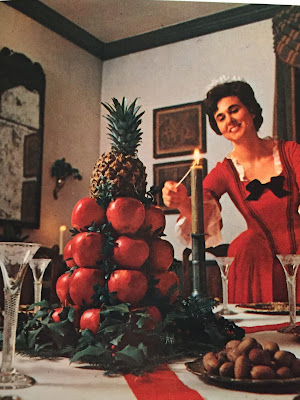by Denise Weimer
Even if
your home is not Early American in architecture, Colonial-style Christmas
decorations revive holiday cheer, especially if you term your design
style traditional, shabby chic, rustic, primitive or cabin. Natural decorations
can provide a much-needed break from glitter and store-bought extravaganza. And
expense! A quick trip to your yard or local nursery, a few basic supplies, and
you’re ready to trim your home in a manner sure to set you apart from the
neighbors.
On
the outside of the house:
Stick
to evergreen swags and wreaths with simple red bows. Non-purists may add fresh
fruit arrangements, although these were not used on the outside of houses until
Colonial Revival times. Hospitality candles in the windows can’t be beat for
creating a mood of welcome.
In
lieu of a Christmas tree:
Trees
weren’t introduced to America until the 1800s, and simple gifts during Colonial times
were only given to servants the day after Christmas – and perhaps to children
on New Year’s. A precursor to the evergreen tree, with a slightly more Early
American feel, was a tree made of goose and turkey feathers. If you do opt for
a tree, consider wrapping gifts in plain brown paper and trimming with natural
fabric bows and greenery sprigs.
On
the dining room table or sideboard:
- A
punch bowl ringed by apples, evergreen or holly
- A
wooden bowl or platter filled with red apples and ivy tendrils
- An apple cone tree topped with a pineapple, filled in with small greenery and placed on a base of magnolia leaves, flanked by pineapples secured on fruit or candle holders
- An
arrangement in a china bowl of white pine, magnolia, holly and cedar – with
cotton bolls as “snow”
At
the fireplace:
- Try a swag of dried apple slices and cinnamon sticks on twine
- Pewter plates, cups and tankards interspersed with holly and evergreen on the mantel
- A holly-topped yule log on the grate. For a party, you might include a nearby bowl of holly sprigs. Colonial English guests tossed a sprig onto the fire to burn up their troubles from the past year.
Extra
touches:
- Wrap balustrades with evergreen swags and bows.
- Accent a key wall by covering a plaque or serving tray with magnolia leaves centered on a cluster of fruit. Pomegranates look especially festive.
- Early Americans loved mistletoe. A Norse legend credited a cluster with not only commanding a kiss, but guaranteeing luck and fertility as well.
- Tuck holly sprigs behind Old English prints and mirror, and mass it around pewter plates.

Research from Internet and “Christmas in Williamsburg,” The Colonial Williamsburg Foundation, 1970, photos by Taylor Biggs Lewis, Jr.





I enjoyed this! Colonial Christmases weren't celebrated with all the fanfare of the present, so I'm always interested to learn of ways Christmas was celebrated in Early America. Thank you, Denise!
ReplyDeleteThanks for sharing. This was interesting.
ReplyDeleteI enjoyed this blog post. I like the older ways of celebrating Christmas and prefer simplier decorations. Thank you for sharing. God bless. Merry Christmas to all.
ReplyDeleteI would so love to decorate this way... If I decorated. (I'm not a scrooge, really!) For decades, I've wanted to visit Williamsburg at Christmastime. It must be amazing!
ReplyDeleteI love the thought of doing Christmas in a simpler fashion, too! One of my favorite Christmas memories through the years is of performing vintage dances at Traveler's Rest GA, an early 1800s stagecoach inn. They decorated in this manner and served the best cider and sugar cookies. Our group's open hearth cook made dinner for all the living historians!
ReplyDeleteThanks for sharing this bit of history. I like the idea of the dried apples and cinnamon sticks on twine.
ReplyDeleteThis was fun! Thanks for sharing this!
ReplyDelete